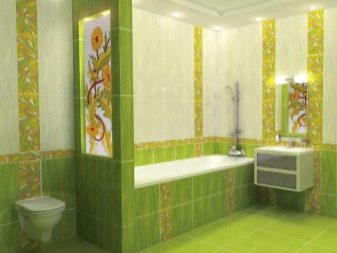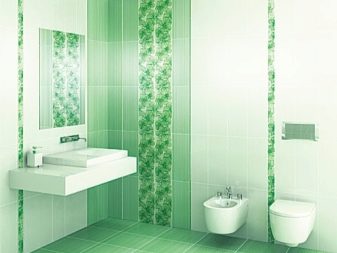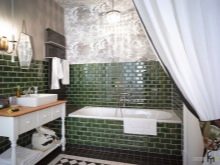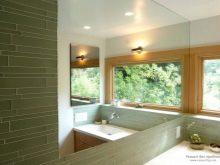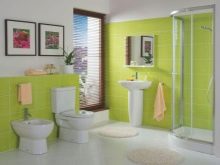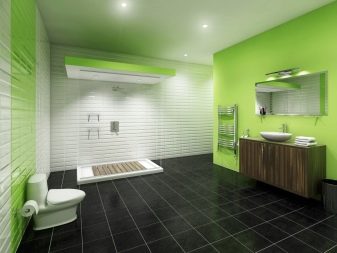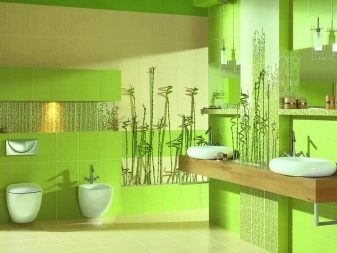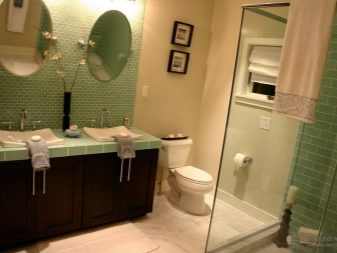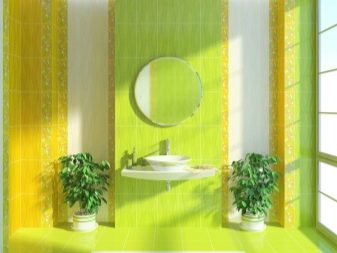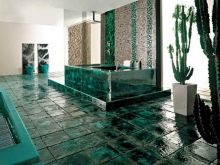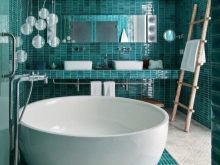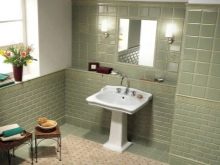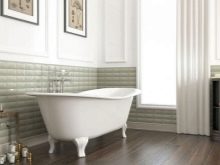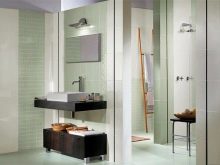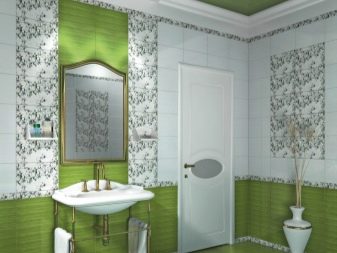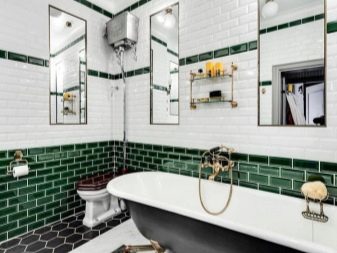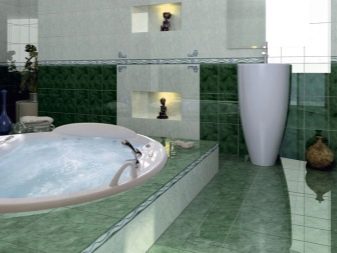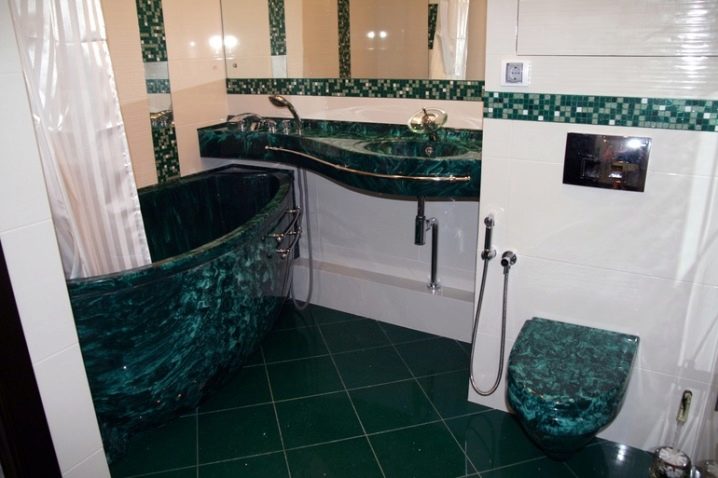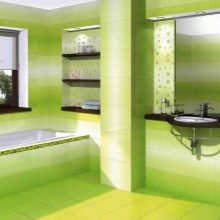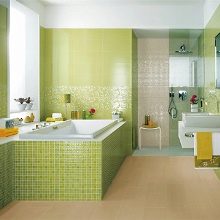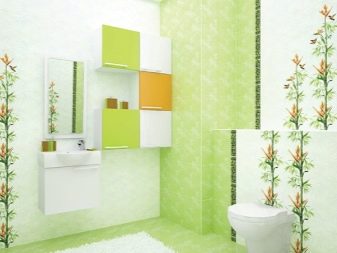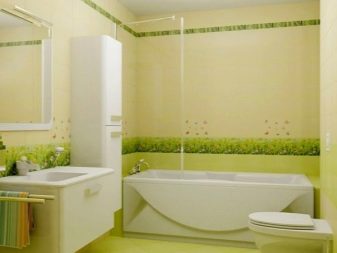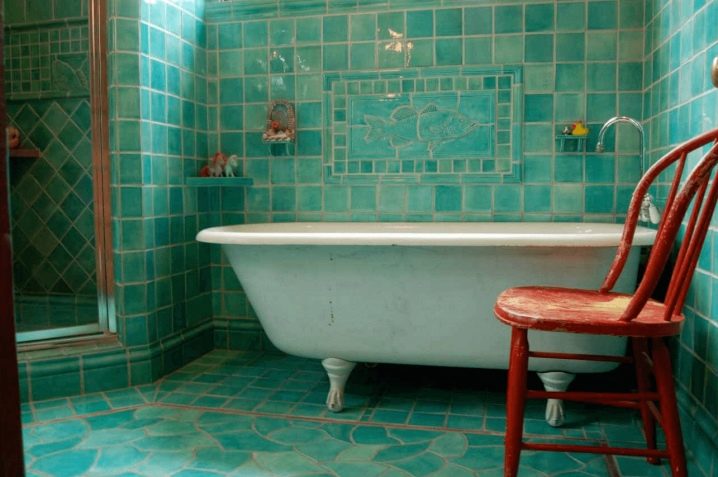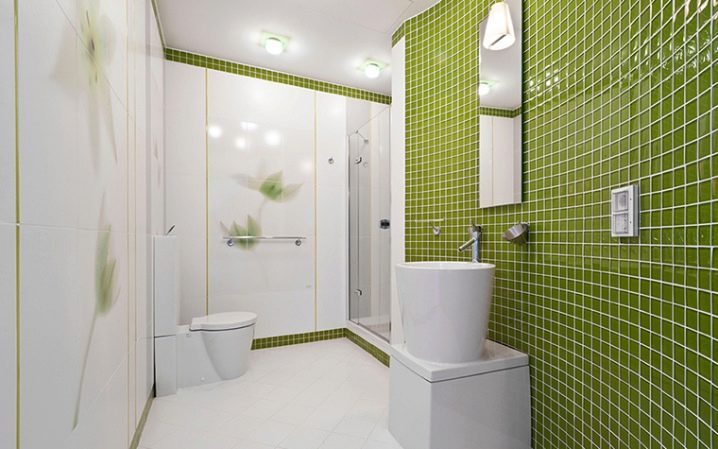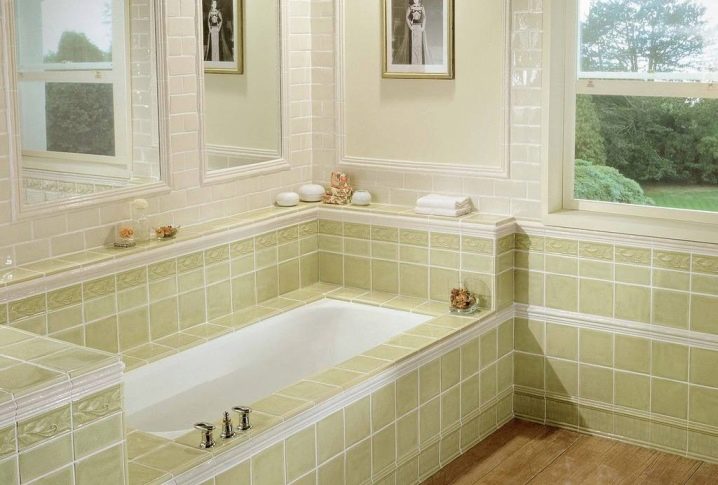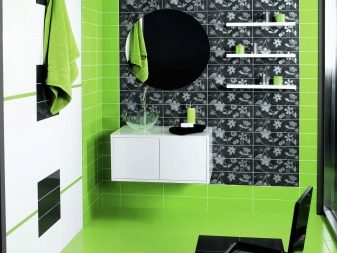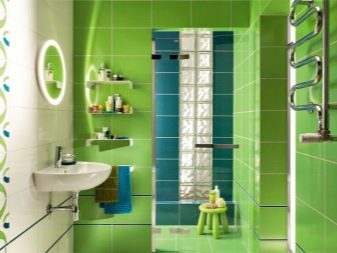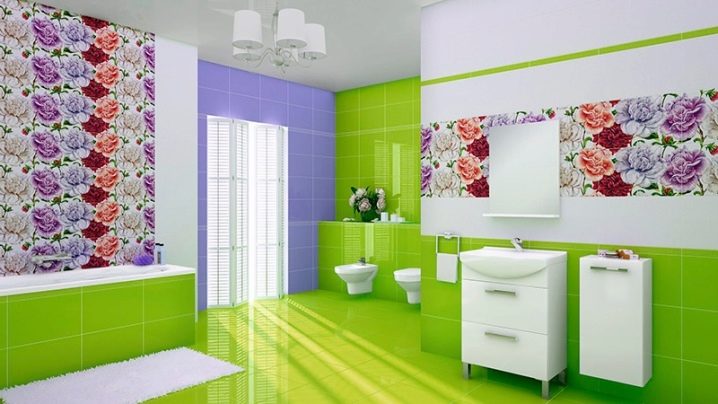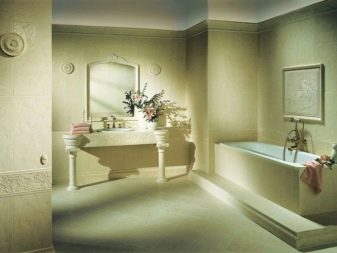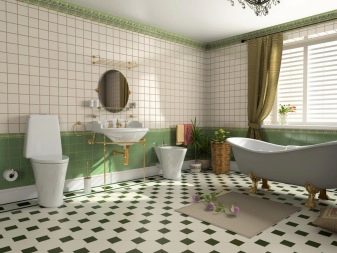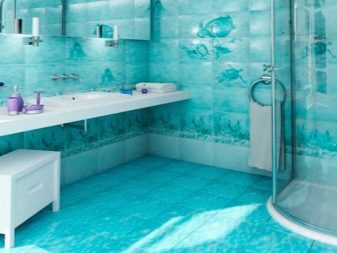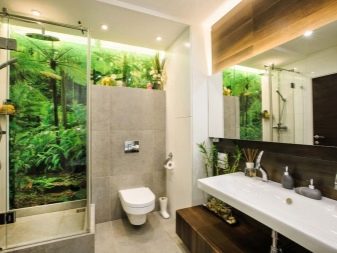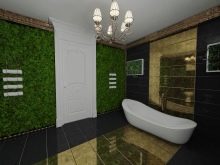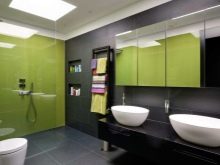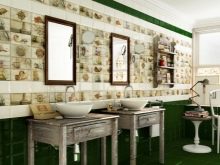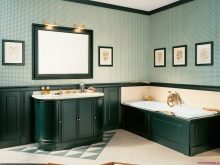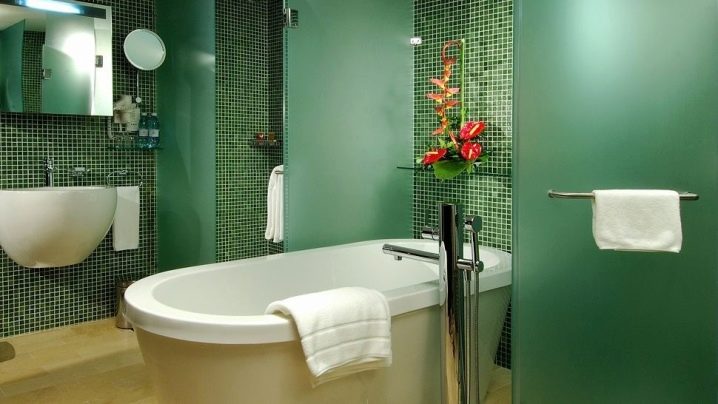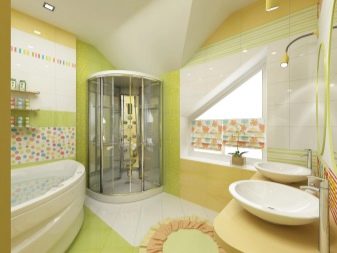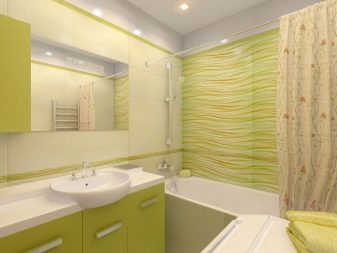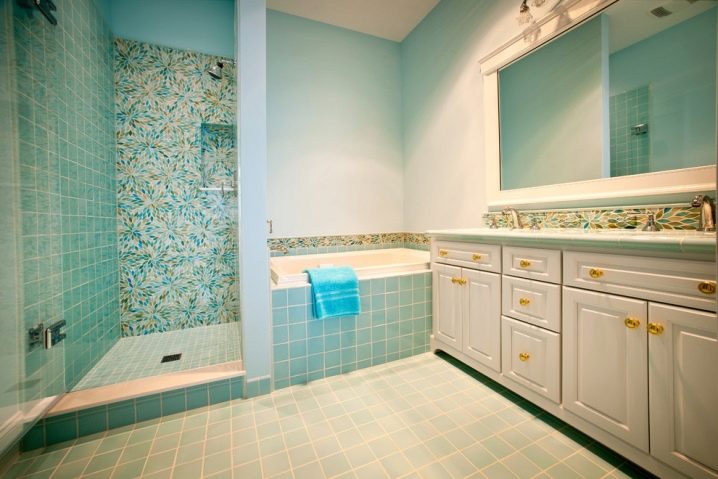How to choose a green tile for the bathroom?

For some people, the words “green bathroom tiles” can cause some shock. The habit of blue, light, gray surfaces comes from a distant childhood. But it is worth stopping for a minute and summer landscapes appear in their memory. Trees with emerald foliage fluttering in the wind, grass with dew drops glistening in the sun, gardens filled with the scent of apples, olive groves. Such memories bring peace to the heart, the desire to slow down the rapid rhythm of elusive days, to enjoy the freshness and comfort.
Special features
Perhaps you came to memory malachite boxes from the Ural fairy tales. Such associations are not accidental.Green is an integral part of a person’s world view, even locked in the stone jungle of the city. It symbolizes rebirth, hope, tranquility, has a beneficial effect on the nervous system, relieves irritation and prevents stress.
In the bathroom, a person meets every morning, comes here after work or study to wash off the fatigue and stress of the day. It is important that the design of this corner of the house is suitable for its residents, so that they feel comfortable and confident here. Before you make a final decision and choose a green product range, you need to consider and feel it. Making sure that the composition corresponds to the inner worldview, does not irritate, creates a desire to act, you can proceed to the choice of the material and the size of the tile.
Kinds
Materials
Products from ceramics and porcelain tiles - the most popular type of finishing materials for the bathroom. It is durable, practical, resistant to high humidity, temperature changes, detergents.
- Enameled tile often used for finishing wall surfaces. It is made from pressed, previously purified clay.Among the advantages are aesthetics, bright and saturated color, ease of care and resistance to cleaning products. However, it creates glare and can irritate the eyes, adversely affecting health. Other disadvantages include a small service life and fragility.
- Matte (unglazed) the surface carries a feeling of warmth and comfort. This tile is obtained in the process of pressing and firing clay. It is rough and not slippery to the touch, and therefore it is more often used as a floor covering. Washing such a surface is not very easy.
- For finishing the floor using porcelain. Its basis is granite, which gives the coating a special appearance, increased strength and stability.
- Terracotta products They have a pleasant and warm texture, they are made from unbaked clay, but they are not coated with glaze. Shades and textures depend on time and the process of production and firing. Today, such a product is made both manually and in factories.
- Textured or decorative tiles looks original and unusual. It can imitate pebbles, air bubbles, metal, wood, cobwebs. In combination with matte or glossy materials, it turns a bathroom into a work of art.
So, ceramic products for floors and walls have different properties.Information about the destination is usually applied to the package. Wall lining denotes a brush pattern, floor - a foot pattern. Shaded foot indicates resistance to wear. The mark "AA" means that the product has a high resistance to perfumery, cosmetics, chemicals and acid.
Dimensions
When choosing ceramic products, it is necessary to pay attention to their thickness and size. The standard material thickness for the floor is 8-11 cm, for walls - 6-7 cm. Product dimensions vary depending on the operating conditions. There are several main species.
Mosaic and small tiles in size from 1x1 cm to 10x10 cm used for finishing floor and wall surfaces. Both options are great for spacious rooms. With the help of decorative borders, assembled from a mosaic, you can decorate the bathroom and visually highlight certain areas, assemble the panel.
The most widespread tile is 20x20 cm or 20x30 cm. It looks beautiful in large and small rooms. The rectangular shape is interesting because it visually increases the space. The horizontal arrangement of details makes the room wider, the vertical - above. Layed diagonally on the floor, it increases its area.
In a large bathroom apply dimensional tiles, they allow you to visually divide it into zones. However, sometimes in one interior products of different sizes are used. So there are unusual geometric and color compositions, the space is modified.
Colors
In the interior design of the bathroom most often used several variations of green.
- Emerald - bright, shining and at the same time calm and life-giving shade of the dark spectrum. In order for the room not to seem too saturated, heavy, it is necessary to diversify the color range.
- Olive - calm, balanced and at the same time light and joyful, looks great with white and warm tones.
- Pistachio - soft, pleasant, spring. There is no obsession and aggressiveness. In combination with pale tones it visually expands the space, and in combination with dark tones it corrects its disadvantages.
- Jade emphasizes severity, elegance and sophistication.
- Malachite - more saturated, powerful shade, creates a feeling of mystery, supernaturalness, freshness and elegance.
- Juicy greens - bright and refreshing; in combination with yellow, it gives rise to lively and vigorous compositions; with brown, it brings a touch of nobility.
- Dead grass - looks great with yellow and white.
- Sea wave - A very popular option. In combination with snow-white can give a feeling of emptiness, pain, and requires revitalizing details and inserts.
- Marshland brings peace, balance and relaxation to the atmosphere. However, when developing a design, one should take into account that a large amount of this shade will create a depressing and oppressive effect.
- Mustard gives warmth and comfort. It is important to combine it with other colors, otherwise there is a risk of getting a dark, gloomy and stuffy closet.
- Green apple - lively, refreshing, invigorating shade. Cream reduces its saturation, soothes. In combination with snow-white this tone visually increases the space.
- Lime - juicy and dazzling color. Calmed by white and cream tones, it creates a spring mood.
Green and blue tiles are also popular. Such tiled products can decorate both the walls and the floor.
Style and design
A variety of colors, dimensions of green tile and beautiful combinations with other colors allow you to use it to create a variety of styles in the bathroom.
- For the Greek style take olive and white material. Enhance the effect of decoration with brown patterns.
- Olive cladding is perfect for vintage style, with the floor is better to lay out the elements of sand colors or a real tree. The atmosphere of antiquity will recreate the plumber on the carved legs.
- Pastel and turquoise tones will help fill the room with a marine atmosphere. A vivid impression will be made by a mosaic depicting waves or flowers of lilies, for example.
- The combination of a shade of fresh greens, pistachio, shortbread will give the effect of rainforest. Living plants, bright towels, wicker furniture will complement this impression.
- The combination of rich green, yellow, gold and light elements will allow to decorate the bathroom in the Art Deco style. Jade and malachite tones are also suitable for him.
- Making one wall green and the other black or white demonstrates the courage and willingness to move forward, be first and take the risk. These are the characteristics of the avant-garde.
- Mosaic - the idea of a combination of tiles of different colors are limited only by the imagination of the designer. Colorful panels, patterns, skillfully placed accents will give the bathroom a charm and uniqueness.
Subtleties of choice
The richness of the shades and textures of the green gamut tile, the variety of ideas and designer finds make it possible to create beautiful interiors.
So that they are stylish and original, not only on the designer's layout, you should pay attention to some nuances.
- Monochrome canvas is better to diversify with other colors, shades or paintings.
- Light colors are more suitable for walls - they expand the space. Dark - for the floor.
- Furniture and accessories must match the chosen style.
- In the green interior looks beautiful white plumbing.
- Natural lighting emphasizes the depth of saturated colors.
- The rich color scheme allows you to combine several styles in one space.
- Metal elements give the interior originality and originality, however, you have to be very careful with them - there is a risk that these details will not fit into the overall picture and destroy harmony.
Successful examples and options
A bathroom option for a man - a harmonious selection of colors, cleanliness, nobility and elegance of the main color, vertical mosaic, conciseness. A red flower, a large chrome faucet, metal inserts and a mirror attract attention and enliven the interior.
A small room is made in light, salad and olive tones. The unusual texture, brown blotches, repeated on the curtain, leaving a feeling of complete harmony. Light colors and a mirror visually expand the space.
The gentle turquoise tint of the walls in combination with white and sand will give the freshness and lightness of the sea coast. The panel and horizontal decorative border make the interior more alive. Golden handles on items of furniture also look great.
On how to lay tiles in the bathroom, you will learn in the next video.

